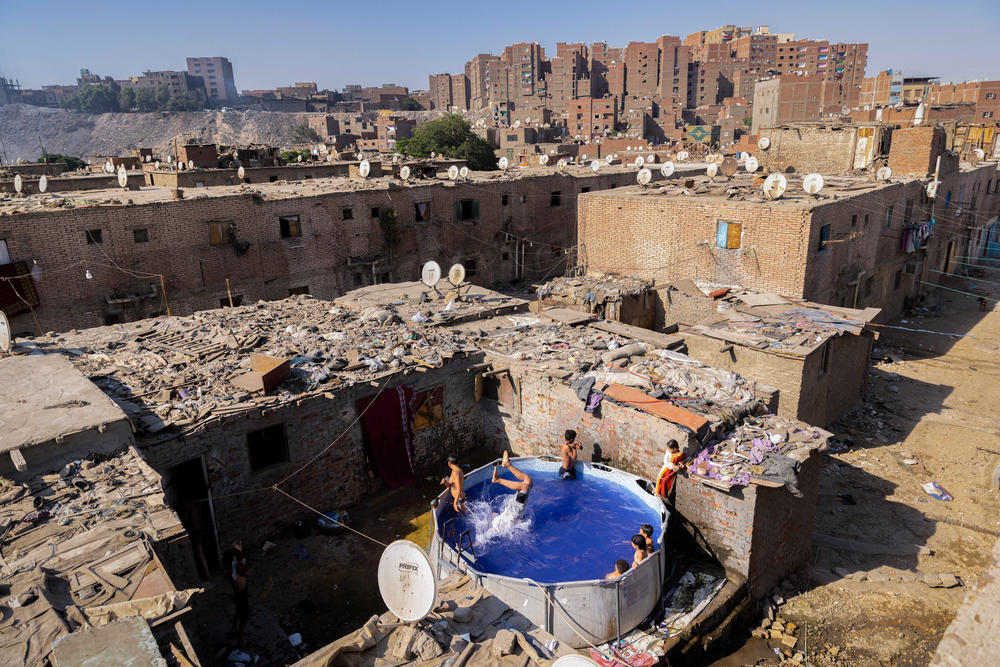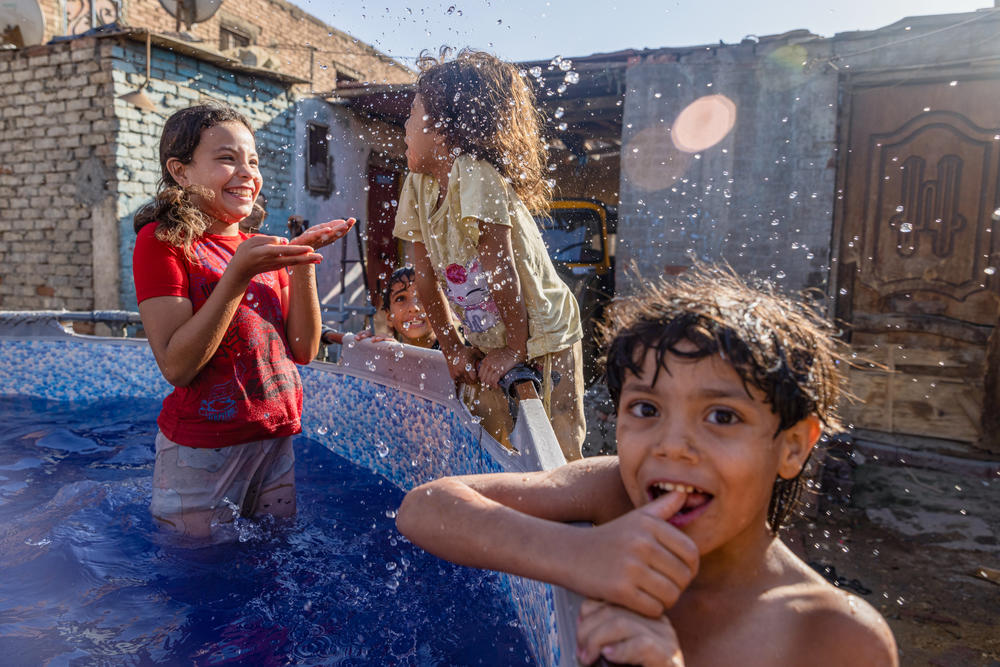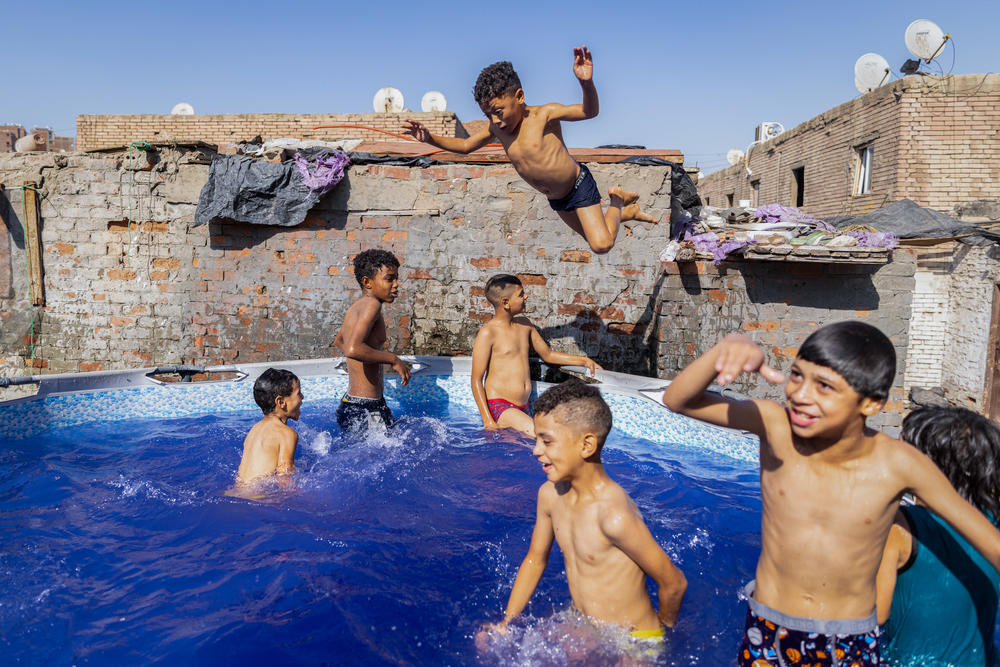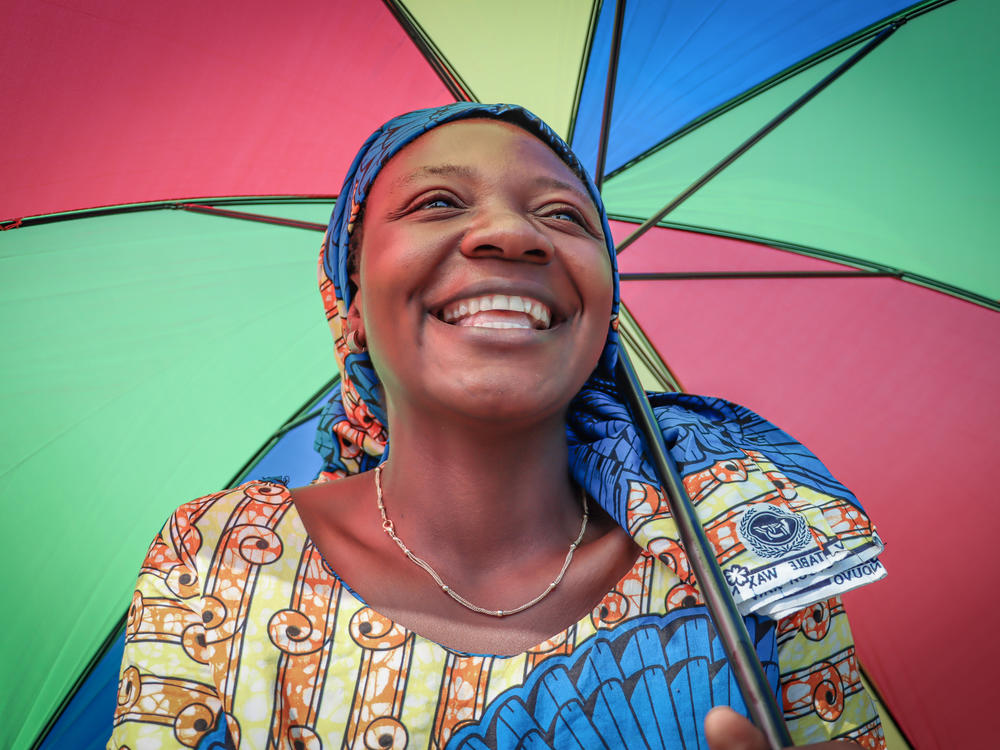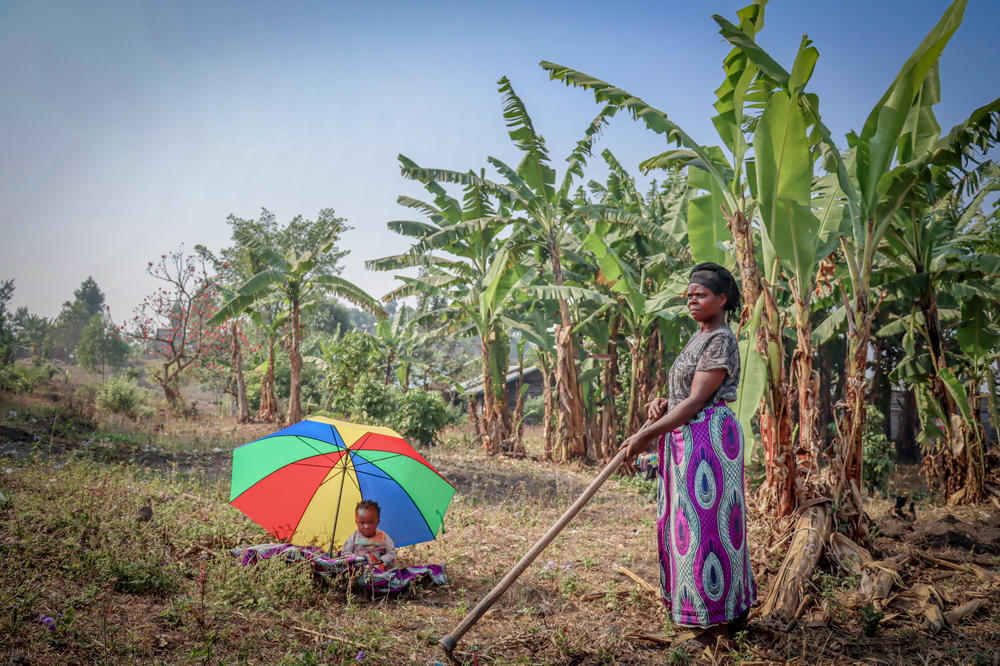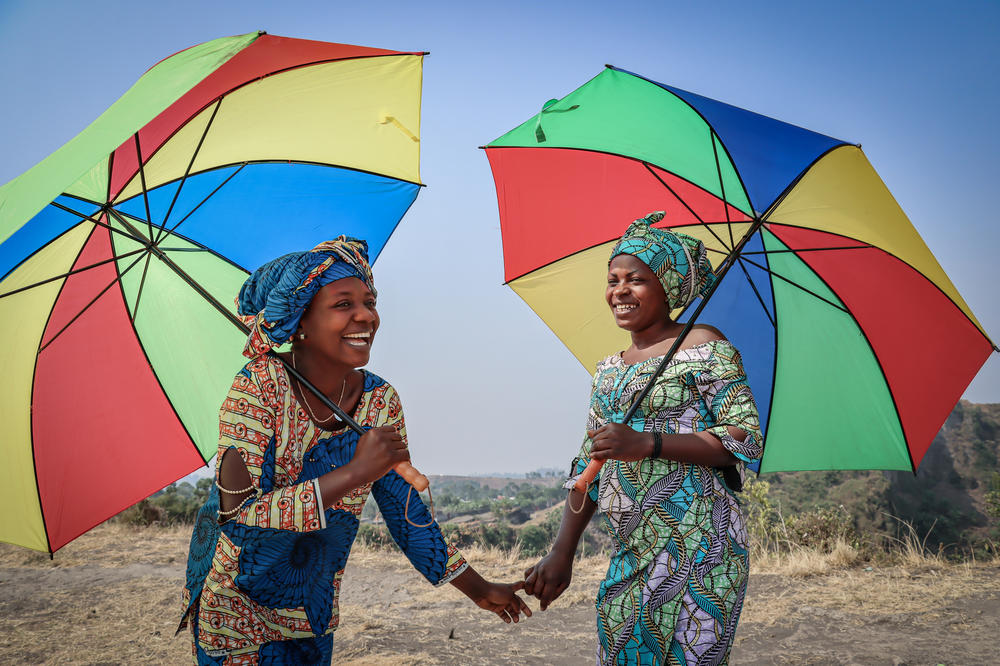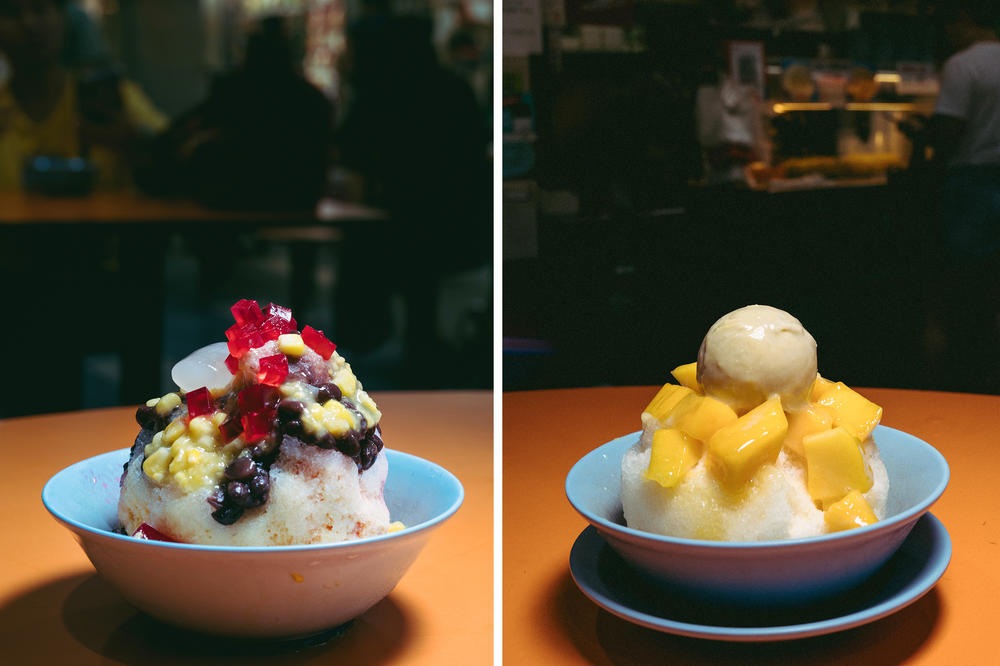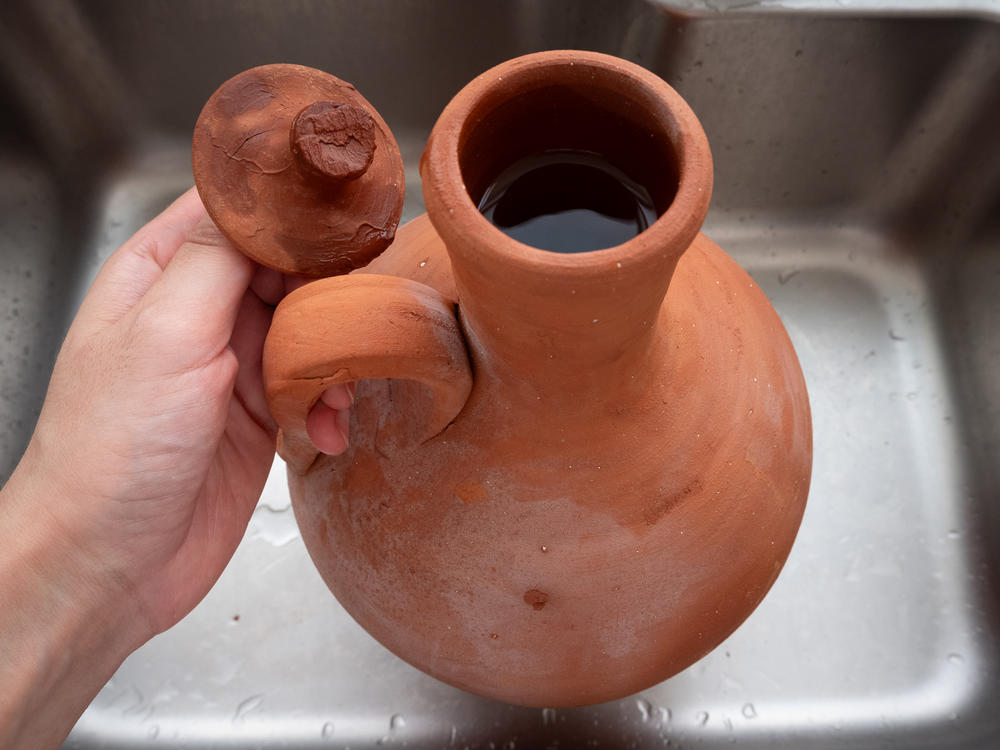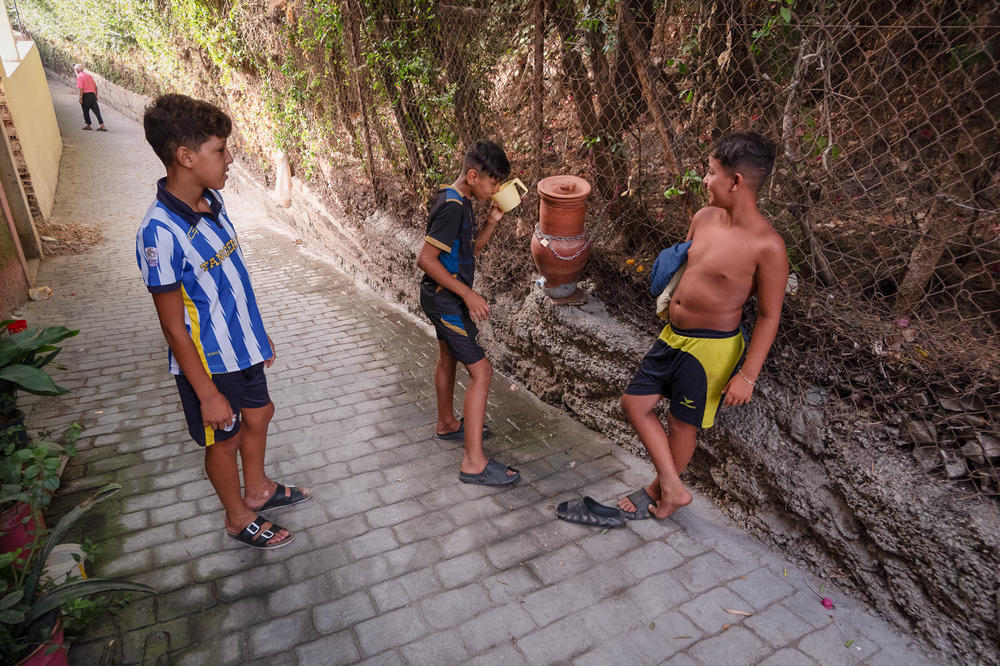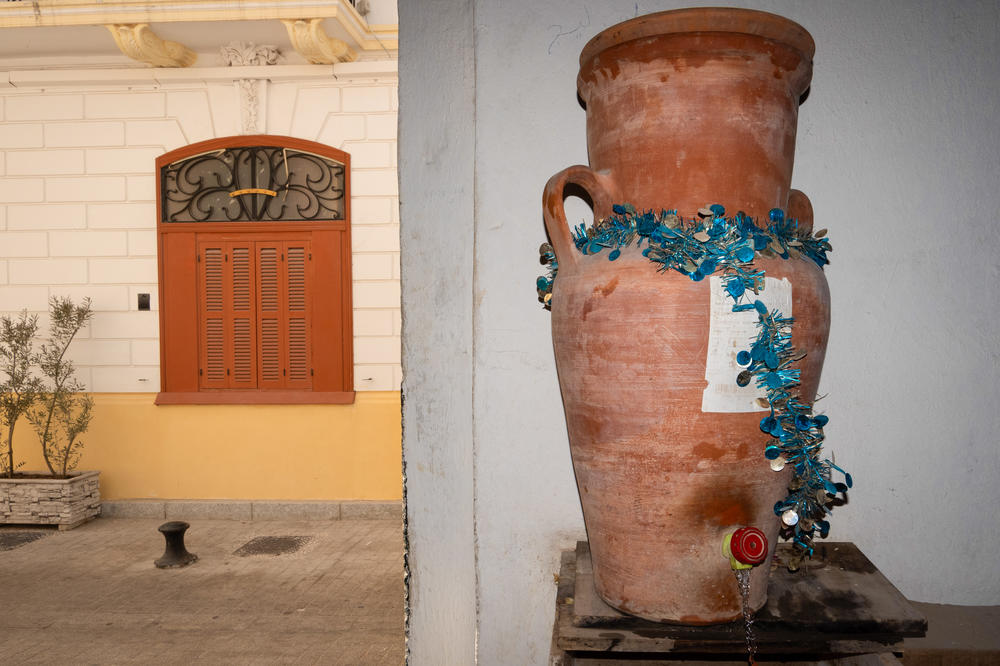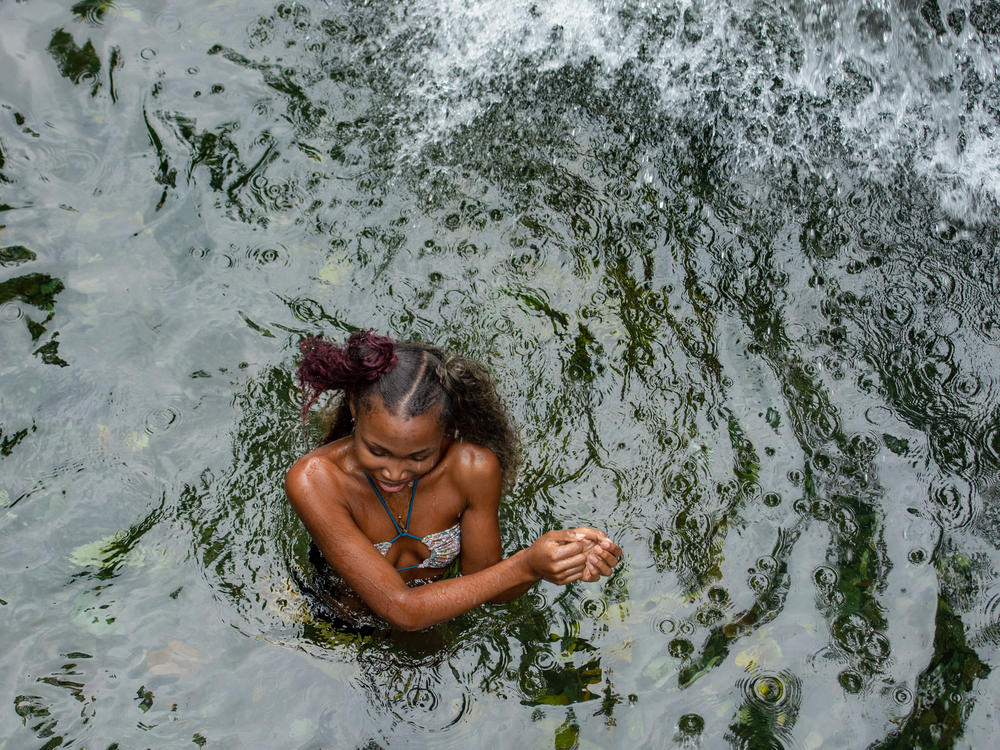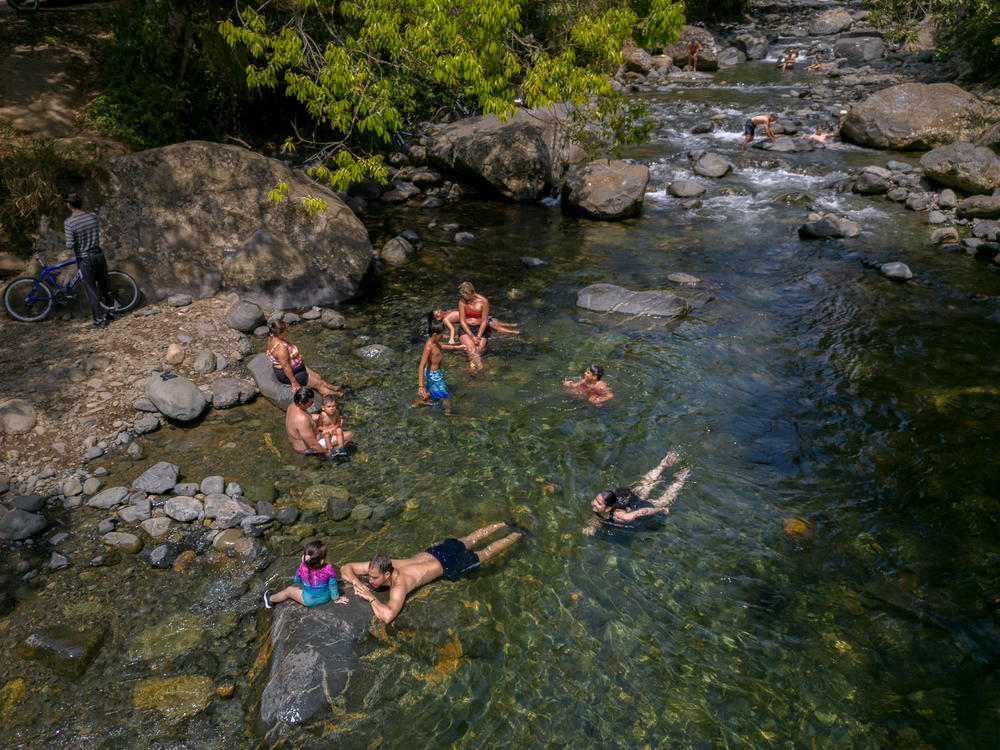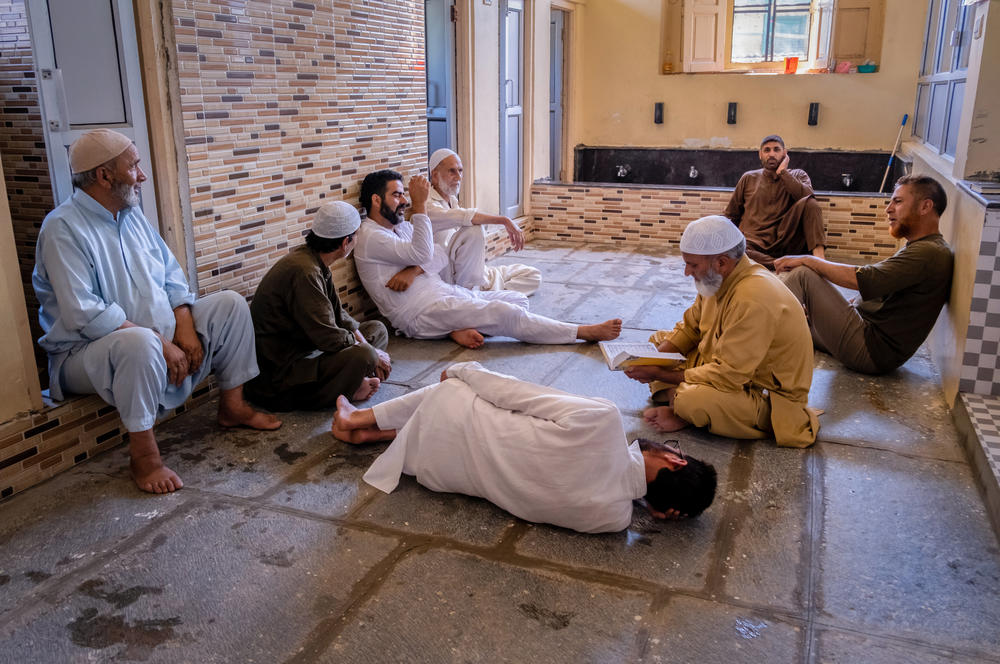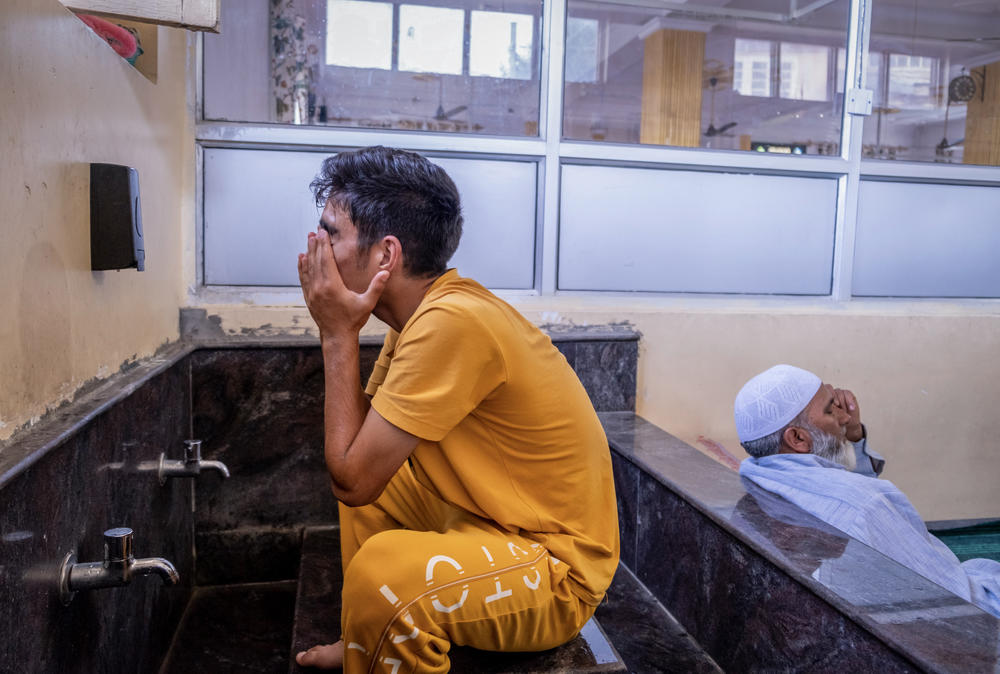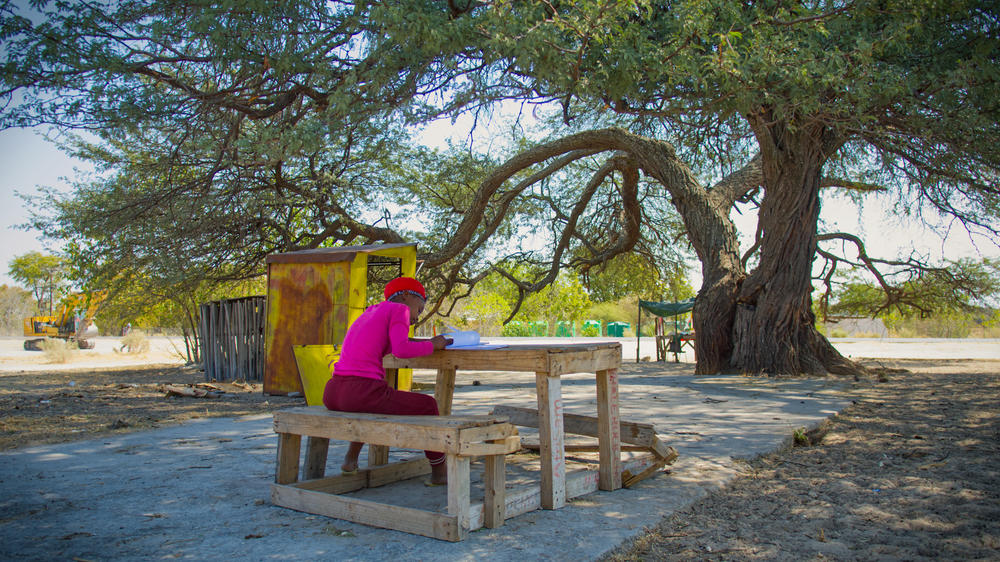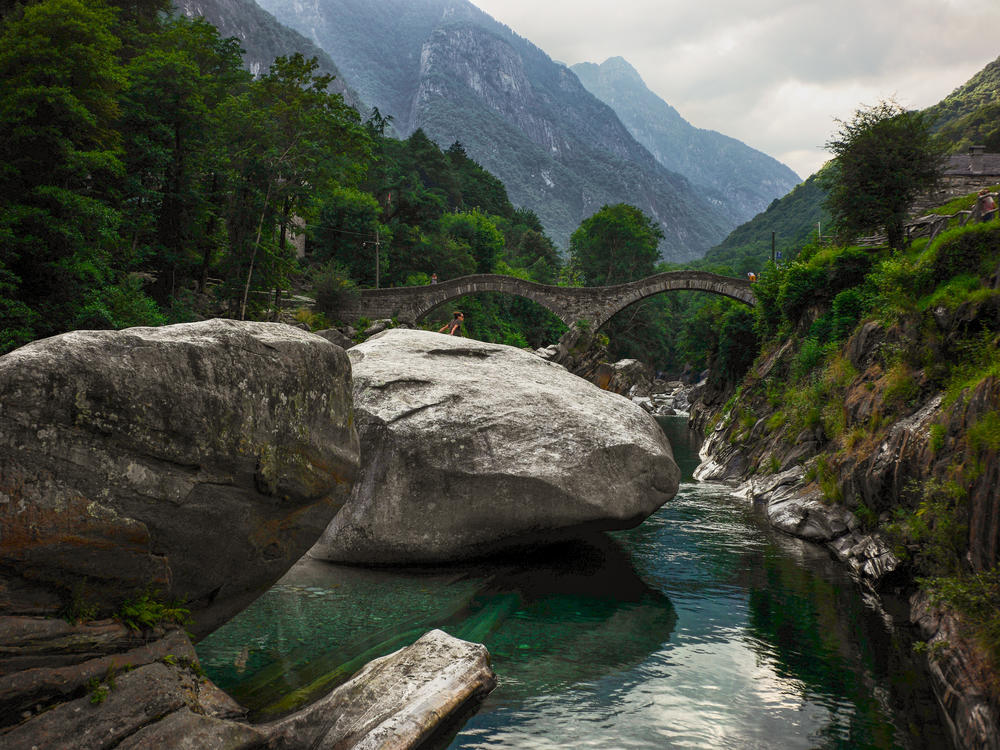Section Branding
Header Content
PHOTOS: Global heat hacks, from jazzy umbrellas in DRC to ice beans in Singapore
Primary Content
The world is hot this year. Ridiculously hot. Fry an egg on the sidewalk hot. How are people dealing with the heat?
We asked the photojournalists of The Everyday Projects to make pictures of heat relief strategies in their countries. Their cameras took aim at the cool floors of a mosque's entryway in Kashmir to swimming, kids splashing in a makeshift pool in a working-class Cairo neighborhood, an icy and affordable treat in Singapore and more. Here are photos of the often centuries-old ways the world is beating the heat.
Pool party in a working-class neighborhood
It started as a family project Um Aya and her late husband, Hussein, hoped would bring their children joy and a reprieve from Cairo heat: a plastic swimming pool.
They set it up on the street outside their home in Manshiyat Naser, El-Deweika, one of the city's working class neighborhoods, where the percentage of people experiencing poverty is high. The pool's striking blue plastic is a sharp contrast to the worn brick homes it sits among.
And joy it brought – along with a surprising business venture. When the neighborhood children flocked to the sounds of splashing water, asking for a chance to swim, the couple saw an opportunity to help support their family. They bought a larger pool in 2015 and charged kids 2 Egyptian pounds (6 cents) to use it – an affordable option in a city where the average public pool costs 30 to 60 Egyptian pounds ($1-2) and hotel pool day passes can be upward of 460 Egyptian pounds (around $15).
Bathing suits a luxury, boys splash and play in their underwear; girls just slightly more covered jump from the wall nearby, a makeshift diving board.
Um Aya takes the pool's cleanliness seriously, changing the water regularly and asking the children to wash the dirt off their bodies, especially their feet, with the hose, before getting in. "Even though this is an improvised setup, we still value cleanliness," she says.
Her son, Hassan,15, acts as pool manager, telling kids when their time is up and occasionally letting in a child or two who can't afford the fee, which this year is up to 5 Egyptian pounds — 14 cents.
Hassan also uses the pool, waiting until the younger kids are gone so he can float peacefully on his back. Hassan's friend Shika says they should make a TikTok of them swimming in "El-Deweika" pool and claim they've reached the North Coast, a luxury beach destination for Egypt's wealthy.
Photographs and story by Roger Anis and Karoline Kamel
The upbeat umbrellas of DRC
When a young girl gets married in the Goma countryside, her family gives her an umbrella to protect her skin from the sun. She gets another one if she has a baby – a necessity if she has her child with her when she goes to work in the fields or sells food or wares by the side of the road.
Women in the city find umbrellas useful as well. On hot days the streets are often dotted with bursts of color.
Umbrellas likely came from Belgium during the period of colonization that spanned the first half of the 20th century. Now they're often imported from China. At a cost of 11,000 Congolese francs ($5) the umbrellas are affordable to many residents.
Néema Byanyira, from the Lac Vert district, says she always has an umbrella at hand. She bought her current one two years ago and carries it to the market, to church and when she visits her sister. She says it helps her stay beautiful and keeps her make-up from running in the sun.
Photos and story by Esther N'sapu
Icy desserts are nice in Singapore
Close to the equator, Singapore is hot and humid. So Singaporeans are experts on how to cool down. One of their favorite ways: an icy sweet treat called ice kachang or ice beans.
The basic idea similar to shaved ice desserts around the world and has had many iterations over the years. It's called "ice beans" because the recipe uses sweetened Adzuki beans, shaved ice, evaporated milk and flavored syrups.
Now countless varieties of the dessert can be found – often including mango puree and jellies such as grass jelly or agar agar.
And even in ultra-wealthy Singapore, these ice desserts are affordable – at least when bought from a vendor at one of the city's many food courts that serve everything from full meals to snacks and desserts. The cost is usually the equialent of $1.50 to $3. Prices at a restaurant are slightly more expensive.
"It is so hot and I've nothing else to do at the moment," said one retired man enjoying an ice kachang. "It's the best way to keep cool, at least for a while."
Photos and story by Amrita Chandradas
The chilling clay pots of Morocco
Many cultures use an ancient vessel — the clay pot — to keep water cool on hot days. Called gollas in Morocco, the pots keep water cool without refrigeration because of the porous nature of clay. An MIT study explains, "The evaporation of water from the outer surface of the clay pot removes heat."
Moroccans keep gollas in their entryways, kitchens, living rooms and on window sills. When someone in the house is thirsty, they just dip in their cup.
And they're a practical way to make sure everyone in a community can find a drink. People often place large gollas, equipped with a spout, in public spaces. They keep the vessels clean and full of fresh water.
Clay vessels are also used in hot countries to keep fruit and vegetables cool.
The continued use of these handmade pots also means the artisans who make them can still earn a living.
Photos and story by Rajaa Khenoussi
A dip in Colombia's popular Pance River
When the summer heat hits Cali, locals and tourists alike head for Pance River. The cold, crisp water of the river makes it a popular weekend spot to cool off while visiting with family and friends, playing music or maybe enjoying sancocho de gallina (a potato- or yucca-based broth with chicken).
"It is important to take advantage of these spaces, take care of them and at the same time share as a family beyond cellphones and shopping malls; and nothing better than this to take advantage of the tradition of the Cali people to come to the river," says Juan, who brings his daughters down to the banks to play.
Colombia's recent heat wave, with temperatures close to 104 Fahrenheit in some areas, has made the Pance and the other six rivers that cross through the city less of a weekend hangout spot and more a respite from the heat seven days a week.
"Sometimes there are so many people in the rivers that it is impossible to find a place to cool off quietly," says Jesús Alfonso, a mechanic who works in the city and belongs to a group of cyclists who take advantage of Cali's rivers after their rides.
Photos and story by Christian EscobarMora
In Kashmir, a mosque's stone floor stays cool in summer
The stone floor feels cool to the touch - like a cold Coke bottle fresh from the refrigerator. It's a shot of relief from the blistering Kashmir sun.
Welcome to the lobby of a mosque, where people stop to wash before prayers in the main hall. The space was actually designed to provide warmth during the harsh Kashmiri winters using an age-old technique: Devri stone slabs (a type of limestone) are placed over a crawl space which is usually two to three feet deep. A fire is made by pushing wood through a small opening from the outside of the mosque and lighting it to keep the floor warm.
In summer, the crawl space is well-ventilated so the floor's surface stays delightfully cool on hot days.
During this record hot summer in the city, worshippers — mainly men --lie down to rest directly on the stones while others sit and read or chat.
Photos and story by Showkat Nanda
Shade and spirituality in Botswana
Trees in Africa offer a practical solution to an increasingly hot country: a patch of shade that's going to keep you cooler than if you were baking the rays of the sun.
But trees offer more than just a place to cool down on a hot day. In Botswana, for example, people gather in the shade of a tree to wash laundry, play games or just chat.
Village elders often have discussions or settle disputes under a tree's canopy. In some communities, elders will teach younger generations in the shade.
Trees also offer a cool place for joy and movement. The dancing and singing at weddings, funerals and harvest festivals takes place under trees as well.
Photos and story by Atang L.S Arnold
A bracing Swiss plunge
The Swiss Alps conjure pictures of cool streams running through tree laden mountains and green valleys. The real deal doesn't disappoint.
A favorite spot to escape the summer heat is the rivers in Valle Verzasca. Visitors flock to the valley to swim in its waters and play in its waterfalls. Luxury cars sit next to cars and vans with camping equipment.
The water in summer can be only 45-50 degrees Fahrenheit. The cold is like "a shock to your body," says a visitor named Pascale. To warm back up, people often lie on nearby stones heated by the sun.
Photo and story by Mahmoud Khattab
Additional credits
Visuals edited by Pierre Kattar and Ben de la Cruz. Text edited by Marc Silver.
Copyright 2023 NPR. To see more, visit https://www.npr.org.
Correction
An earlier version of this story misspelled the Pance River as the Pence River.
